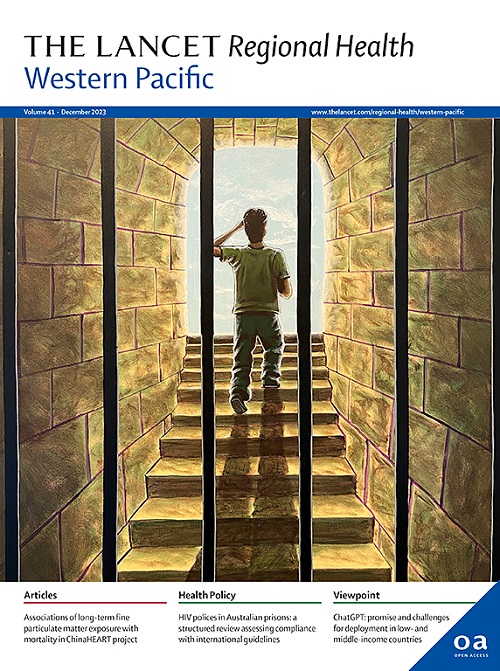Pathogen distribution and antimicrobial resistance among neonatal bloodstream infections in Southeast Asia: results from NeoSEAP, a multicentre retrospective study
IF 8.1
1区 医学
Q1 HEALTH CARE SCIENCES & SERVICES
引用次数: 0
Abstract
Background
Progress in reducing morbidity and mortality due to neonatal sepsis has slowed in recent decades and is threatened by the global rise of antimicrobial resistance. The populous Southeast Asian region has a high burden of both neonatal sepsis and antimicrobial resistance (AMR). Despite this, there remains a lack of robust data on the epidemiology of neonatal sepsis and the prevalence of AMR within the region.
Methods
We evaluated positive blood cultures and susceptibility profiles responsible for neonatal sepsis across 10 clinical sites in five countries in South and Southeast Asia (Sri Lanka, Indonesia, The Philippines, Malaysia, and Vietnam). Retrospective data on all blood cultures collected from neonates over two years (1st January 2019–31st December 2020) were extracted from laboratory records. Data were also collected on the availability and implementation of infection prevention and control resources, and antimicrobial prescribing practices. Pooled estimates across sites and pathogens were generated, with adjustment for clustering.
Findings
Of 14,804 blood cultures collected over the study period, a total of 2131 positive isolates (including 1483 significant pathogens) were identified. Gram-negative bacteria predominated as causative of neonatal sepsis (78·4%; 1163/1483) with Klebsiella spp. (408/1483; 27·5%) and Acinetobacter spp. (261/1483; 17·6%) most frequently isolated overall. Adjusted pooled non-susceptibility for Klebsiella spp. was 86·7% (95% CI 54·0–98·5) for third-generation cephalosporins (ceftriaxone and/or cefotaxime; 3GC) and 17·1% (95% CI 8·1–24·7) for carbapenems; while non-susceptibility for Escherichia coli was 46·4% (95% CI 20·0–72·0) for 3GC and 15·4% (95% CI 2·7–31·0) for carbapenems. Carbapenem non-susceptibility for Acinetobacter spp. was 76·5% (95% CI 59·4–84·5). Gram-positive bacteria accounted for 13·2% (196/1483) of pathogens causative of neonatal sepsis, whilst Candida spp. accounted for 8·3% (123/1483) of culture-positive sepsis episodes.
Interpretation
Neonatal sepsis in tertiary hospitals in Southeast Asia is predominantly caused by gram-negative bacteria, with high rates of non-susceptibility to commonly prescribed antibiotics.
Funding
This study was supported by an Australian National Health and Medical Research Council (NHMRC) grant. The NHMRC was not involved in the design or conduct of the research.
东南亚新生儿血流感染中的病原体分布和抗菌素耐药性:NeoSEAP的结果,一项多中心回顾性研究
近几十年来,降低新生儿败血症发病率和死亡率的进展缓慢,并受到全球抗菌素耐药性上升的威胁。人口稠密的东南亚地区在新生儿败血症和抗菌素耐药性(AMR)方面负担沉重。尽管如此,该地区仍缺乏关于新生儿败血症流行病学和抗菌素耐药性流行率的可靠数据。方法:我们评估了南亚和东南亚5个国家(斯里兰卡、印度尼西亚、菲律宾、马来西亚和越南)10个临床站点的新生儿败血症阳性血培养和易感性特征。从实验室记录中提取了两年内(2019年1月1日- 2020年12月31日)收集的所有新生儿血培养物的回顾性数据。还收集了关于感染预防和控制资源的可获得性和实施情况以及抗微生物药物处方做法的数据。在对聚类进行调整后,生成了跨站点和病原体的汇总估计。在研究期间收集的14804份血培养物中,共鉴定出阳性分离物2131株(其中显著病原菌1483株)。革兰氏阴性菌是导致新生儿败血症的主要细菌(78.4%;1163/1483),其中克雷伯氏菌(408/1483;27.5%)和不动杆菌(261/1483;17.6%)最常见。克雷伯氏菌对第三代头孢菌素(头孢曲松和/或头孢噻肟;3GC)的调整后总非敏感性为86.7% (95% CI为54.0 ~ 98.5),对碳青霉烯类的调整后总非敏感性为17.1% (95% CI为8.1 ~ 24.7);大肠杆菌对3GC和碳青霉烯类的非敏感性分别为46.4% (95% CI 20.0 ~ 72.0)和15.4% (95% CI 2.7 ~ 31.0)。碳青霉烯类对不动杆菌的不敏感性为76.5% (95% CI为59.4 ~ 84.5)。革兰氏阳性菌占新生儿脓毒症病原菌的13.2%(196/1483),念珠菌占培养阳性脓毒症的8.3%(123/1483)。东南亚三级医院的新生儿败血症主要由革兰氏阴性菌引起,对常用抗生素不敏感的比例很高。本研究由澳大利亚国家健康和医学研究委员会(NHMRC)资助。NHMRC没有参与这项研究的设计或实施。
本文章由计算机程序翻译,如有差异,请以英文原文为准。
求助全文
约1分钟内获得全文
求助全文
来源期刊

The Lancet Regional Health: Western Pacific
Medicine-Pediatrics, Perinatology and Child Health
CiteScore
8.80
自引率
2.80%
发文量
305
审稿时长
11 weeks
期刊介绍:
The Lancet Regional Health – Western Pacific, a gold open access journal, is an integral part of The Lancet's global initiative advocating for healthcare quality and access worldwide. It aims to advance clinical practice and health policy in the Western Pacific region, contributing to enhanced health outcomes. The journal publishes high-quality original research shedding light on clinical practice and health policy in the region. It also includes reviews, commentaries, and opinion pieces covering diverse regional health topics, such as infectious diseases, non-communicable diseases, child and adolescent health, maternal and reproductive health, aging health, mental health, the health workforce and systems, and health policy.
 求助内容:
求助内容: 应助结果提醒方式:
应助结果提醒方式:


